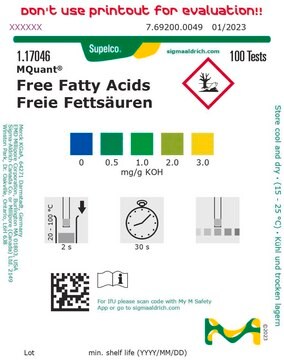MAK156
Fatty Acid Uptake Kit
sufficient for 100 fluorometric tests
Sign Into View Organizational & Contract Pricing
All Photos(2)
About This Item
Recommended Products
usage
sufficient for 100 fluorometric tests
detection method
fluorometric
relevant disease(s)
endocrinological disorders, diabetes; gastrointestinal diseases; cancer
storage temp.
−20°C
Related Categories
General description
Fatty acids are critical for many biological processes including energy metabolism and the synthesis of structural cellular components. The facilitated uptake of fatty acids, presumably through fatty acid transport proteins, is thought to be regulated at multiple levels. The dysregulation of fatty acid uptake may contribute to diseases such as obesity, type 2 diabetes, and hepatic steatosis.
Suitability
This kit is suitable for the measurement of fatty acid uptake in cells containing fatty acid transporters
Principle
This kit is provides a simple and sensitive method for the measurement of fatty acid uptake in cells containing fatty acid transporters. This kit uses a proprietary dodecanoic acid fluorescent fatty acid substrate whose uptake into cells result in an increase in fluorescence intensity (λex = 485/λem = 515 nm).
Storage Class Code
10 - Combustible liquids
Certificates of Analysis (COA)
Search for Certificates of Analysis (COA) by entering the products Lot/Batch Number. Lot and Batch Numbers can be found on a product’s label following the words ‘Lot’ or ‘Batch’.
Already Own This Product?
Find documentation for the products that you have recently purchased in the Document Library.
Stephanie Kim et al.
Environmental health perspectives, 129(7), 77006-77006 (2021-07-30)
Chemicals in disparate structural classes activate specific subsets of the transcriptional programs of peroxisome proliferator-activated receptor-γ (PPARγ) to generate adipocytes with distinct phenotypes. Our objectives were to a) establish a novel classification method to predict PPARγ ligands and modifying chemicals;
Mona S Nilsen et al.
Diabetes, 69(9), 1903-1916 (2020-06-27)
Circulating branched-chain amino acids (BCAAs) associate with insulin resistance and type 2 diabetes. 3-Hydroxyisobutyrate (3-HIB) is a catabolic intermediate of the BCAA valine. In this study, we show that in a cohort of 4,942 men and women, circulating 3-HIB is
Rong Huang et al.
JCI insight, 4(18) (2019-09-20)
Age is a well-established risk factor for impaired bone fracture healing. Here, we identify a role for apolipoprotein E (ApoE) in age-associated impairment of bone fracture healing and osteoblast differentiation, and we investigate the mechanism by which ApoE alters these
Stephanie Kim et al.
Archives of toxicology, 94(9), 3087-3103 (2020-07-20)
Triphenyl phosphate (TPhP) is an environmental PPARγ ligand, and growing evidence suggests that it is a metabolic disruptor. We have shown previously that the structurally similar ligand, tributyltin, does not induce brite adipocyte gene expression. Here, using in vivo and
Xingzhe Ma et al.
Cell metabolism, 33(5), 1001-1012 (2021-03-11)
Understanding the mechanisms underlying how T cells become dysfunctional in a tumor microenvironment (TME) will greatly benefit cancer immunotherapy. We found that increased CD36 expression in tumor-infiltrating CD8+ T cells, which was induced by TME cholesterol, was associated with tumor progression and
Our team of scientists has experience in all areas of research including Life Science, Material Science, Chemical Synthesis, Chromatography, Analytical and many others.
Contact Technical Service




